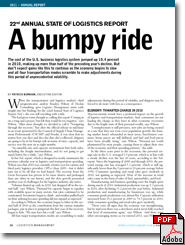2011 State of Logistics: Rail
Steady growth on the rails
Latest Logistics News
LM Podcast Series: Assessing the freight transportation and logistics markets with Tom Nightingale, AFS Logistics Investor expectations continue to influence supply chain decision-making Under-21 driver pilot program a bust with fleets as FMCSA seeks changes Diesel back over $4 a gallon; Mideast tensions, other worries cited Four U.S. railroads file challenges against FRA’s two-person crew mandate, says report More NewsAs the economic recovery has been riding waves of both optimism and anxiety, there’s been one stable constant in the freight transportation environment: the railroad sector. But before we examine the rails at the mid-point of 2011, we’re best served by considering where the market was at this point in 2010—and that was in major recovery mode on the heels of a dismal 2009.
Since that time, it’s fair to say that things are better from a volume perspective. However, volumes are still not back to the pre-recession levels witnessed in 2007. Those levels, say industry experts, won’t be back for a while. But since the first half of 2010, the railroad industry appears to be back on track, with solid earnings and strong pricing clearly intact. As for volumes, rail carloads and intermodal containers and trailers are up roughly 4 percent and 10 percent, respectively, year-over-year for the first half of 2011.
“There is improved volume and improved confidence that as an economy we have moved past recovery into whatever the next phase will be—perhaps a slow growth phase,” said Tony Hatch, principal of New York-based ABH Consulting. “A year ago at this time there were questions about how sustainable things really were due to issues like the short-term economic stimulus and Cash for Clunkers.”
Independent of the pace in railroad volume growth, it’s clear that the uptick in confidence on the rails is also playing out in terms of capital expenditure investments being doled out by Class I railroads.
|
|
|
|
Visit the 2011 Quest for Quatlity Winners NATIONAL LTL | REGIONAL LTL | TRUCKLOAD | RAIL | |
In March, the Association of American Railroads (AAR) stated that U.S.-based freight railroads are planning to spend $12 billion in capital expenditures in 2011, following a $10.7 billion investment in 2010. The 2011 tally would be a new record, with 2010 being the current record for railroad capital expenditures, according to the AAR.
“The railroad industry is not on the sidelines,” said AAR President and CEO Ed Hamberger. “This industry has been in the game. The $12 billion investment for 2011 follows three years where we averaged $10 billion per year; and up to this year they were the three highest years on record for capital expenditures, which occurred during the middle of the worst recession since the Great Depression.”
Hamberger also noted that these capital expenditure investments are funded by private capital and not taxpayer funding, adding that the railroad industry owns, maintains, improves, and pays taxes on their rights-of-way. Other costs comprised in capital expenditures include maintenance, with 20 cents of every revenue dollar going back into maintaining, expanding, and improving the U.S. rail network over the last 10 years.
Coupled with these expenses allocated towards rail investment is pricing power, which the railroads have had on a consistent basis going back to 2003. As has been the case for years, rail shippers have fought rate increases tooth and nail, citing how they are not getting enough “bang” for their railroad buck. This is especially true for captive shippers.
How the stand-off over rates between rail carriers and shippers plays out is far from settled, given the holding pattern that legislative efforts to re-regulate the industry—and re-authorize the STB—is in. However, rail shippers continue to make it clear that they are not satisfied with the status quo.
“Railroads have pricing power with captive shippers, and it is take it or leave it with rates,” said Mike Snovitch, executive director of the Alliance for Rail Competition. “They are stuck with what railroads charge and filing a rate challenge case with the STB is a long costly process. Rail shippers want and need a truly friendly bill to help better meet their needs.”

Article Topics
Latest in Logistics
LM Podcast Series: Assessing the freight transportation and logistics markets with Tom Nightingale, AFS Logistics Investor expectations continue to influence supply chain decision-making The Next Big Steps in Supply Chain Digitalization Under-21 driver pilot program a bust with fleets as FMCSA seeks changes Diesel back over $4 a gallon; Mideast tensions, other worries cited Four U.S. railroads file challenges against FRA’s two-person crew mandate, says report XPO opens up three new services acquired through auction of Yellow’s properties and assets More LogisticsAbout the Author
Subscribe to Logistics Management Magazine

Find out what the world's most innovative companies are doing to improve productivity in their plants and distribution centers.
Start your FREE subscription today.
April 2023 Logistics Management

Latest Resources
















